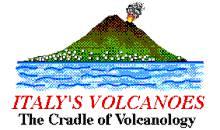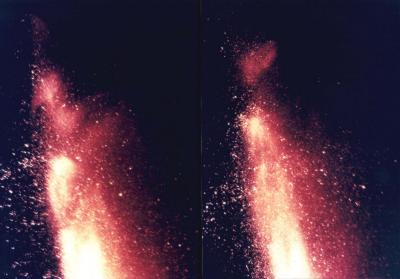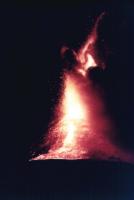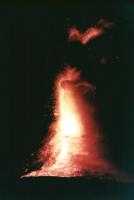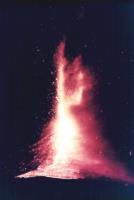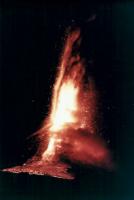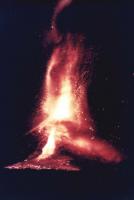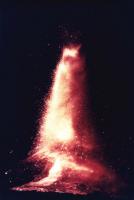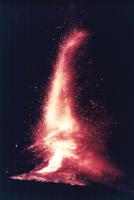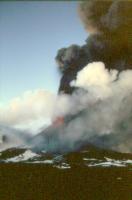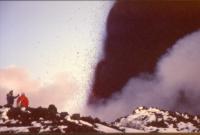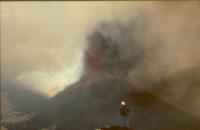|
NEW:
Excursions to the Etna area, The Etna telecamera is maintained by the "Sistema Poseidon" and there is no relationship of any kind with this site and its author. The Poseidon web site is in Italian, and the link to the telecamera is changed frequently, so that it is not indicated here (click on "Etna live cam" on the Poseidon home page). Please note also that all information provided on the present page (and the archived Etna news pages) is informal, based on personal observations, and is not intended to substitute, or compete with, the news bulletins now issued regularly at the Poseidon web site.
14
March 2000 update.
An episode of vigorous eruptive activity occurred on the morning of
14 March at the Southeast Crater, following less than two days of
relative quiet. Although little detail about this activity is known,
it seems that most activity again occurred from the new crater at
the southern base of the SE Crater cone. Lava was emitted to form
several flows that covered lavas erupted during earlier eruptive episodes,
and some passed again very close to the Torre del Filosofo mountain
hut, which had been reached, but not destroyed, by lava emitted during
the previous eruptive episode on 12 March. In that event, lava had
reportedly consumed the wooden shack standing next to the building
on its eastern side, where tourists could buy postcards, slide sets
and other souvenirs and have a coffee or a sip of the highly alcoholic
"Fuoco dell'Etna" during the past summer seasons. Lava was
also reported to have touched the northern and western sides of the
main Torre del Filofoso building on 12 March. 12
March 2000 update.
Once more, the repose period between eruptive episodes at the Southeast
Crater lasted a bit more than 4 days. At around 1300 h (local time=GMT+1)
on 12 March, a new episode of strong eruptive activity started from
vents at the southern base of the SE Crater cone. Observers in Adrano
(on the southwestern flank of Etna) reported that they could see lava
fountains "which definitely came not from the summit vent of
the SE Crater". During the night prior to the eruptive episode,
lava emission had resumed, after two days of no effusive activity,
from one or more vents at the southern base of the SE Crater cone,
and it is possible that the initial vigorous activity originated at
the same vents. Sometime after 1400 h it was seen that the SE Crater
displayed vigorous ash emission from its summit vent, while small
lava fountains played from a vent (or maybe several vents) at the
southern base of its cone. Lava flows were extending towards SW and
S, the latter passing at a very short distance (maybe only a few tens
of meters) to the W of the Torre del Filosofo mountain hut and descending
the somewhat steeper slope below, where the day before a crew of the
SITAS (the society which owns the cable car on Etna's S flank) had
cleared the access road to the Torre del Filosofo. Guided tours to
the summit area were to be resumed during the next week, but the new
lava which has interrupted the road may have rendered this uncertain. 8
March 2000 update.
After another period of relative calm of slightly more than 4 days,
the Southeast Crater erupted again sometime around 0900 h (local time=GMT+1)
on 8 March. The eruptive episode was preceded by increased lava outflow
on the northern flank of the cone; there does not appear to have been
any activity at the southern base this time. It also seems that the
activity at the culminating stage of the eruptive episode was much
weaker than during most of its predecessors. 4
March 2000 update.
The Southeast Crater erupted again on the early morning of 4 March,
after 4.5 days of quiet. The new eruptive episode - the 38th since
26 January - was preceded by slow lava extrusion on the N flank of
the SE Crater cone, and a bright glow from the new crater on the S
base of the cone. This glow was already visible after sunset on 3
March and gradually intensified during the night. Sometime around
0400 h (local time=GMT+1), Giuseppe Scarpinati who slept in his home
in Acireale was awakened by loud detonations and saw vigorous Strombolian
activity at the SE Crater. Scarpinati noted that even at its culmination
the paroxysm did not produce dense, continuous fountains like during
many of the earlier paroxysms. 1
March 2000 update.
During a summit visit by Behncke and others on the afternoon of 29
February, eruptive activity at Etna's summit craters was limited to
mild explosive activity at the Bocca Nuova (which, however, produced
dozens of beautiful "smoke" rings) and ash emission from
the Northeast Crater, which had shown little activity since early
October 1999. The Southeast Crater, source of a paroxysmal eruptive
episode on 28 February, was quiet, but had a few incandescent spots
on its lower southern flank, probably where hot gas escaped through
fissures. 29
February 2000 update.
The Torre del Filofoso building may have survived, at least partially,
the eruption from the SE Crater on the evening of 28 February. However,
lava flowed throughout the night from a vent on the southern base
of the SE Crater cone towards southwest. The eruptive activity on
28 February caused light shower of ash onto Catania and surrounding
areas. More detailed information will be made available as soon as
possible. 28
February 2000 update.
Unconfirmed information on the evening of 28 February reports that
during the latest eruptive episode from the Southeast Crater, lava
flows have reached the building of the Torre del Filosofo mountain
hut, located only about 1 km south of the erupting crater, and lava
flows are slowly advancing towards south a few hundred meters to the
west of the building. Several other web pages covering the October-November 1999 eruptions of the Bocca Nuova have recently been posted; these contain photos and movie clips of some of the most spectacular moments of that period. A photo gallery covering the period September-November 1999 (with photos by Boris Behncke and Giuseppe Scarpinati) Photos of the eruptive activity, 26-31 October 1999, by Tom Pfeiffer (University of Arhus, Denmark) Photos by Marco Fulle, 17-23 October 1999, at Stromboli On-line - Marco at his best Very impressive video clips, taken by Roberto Carniel on 17-23 October 1999, at Stromboli On-line Photos by Juerg Alean, of 1 November 1999, at Stromboli On-line Video clips, taken by Juerg Alean on 1 November 1999, at Stromboli On-line A
page by Charles Rivière, France, with many photos of the summer
and autumn of 1999 (in French) |
||||||||||||||||||||||
|
Copyright
© Boris Behncke, "Italy's Volcanoes: The Cradle of Volcanology"
|
|||||||||||||||||||||||
|
Page
set up on 27 May 1997, last modified on 14 March 2000
|
|||||||||||||||||||||||
